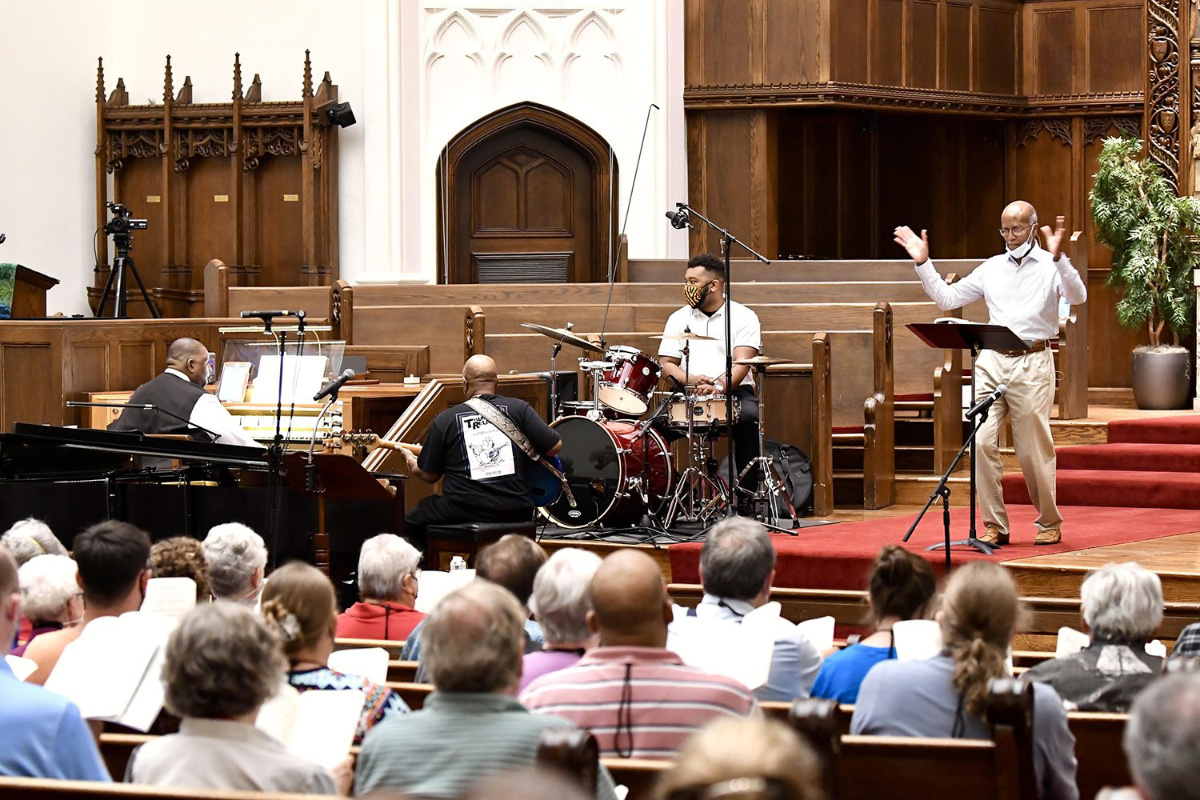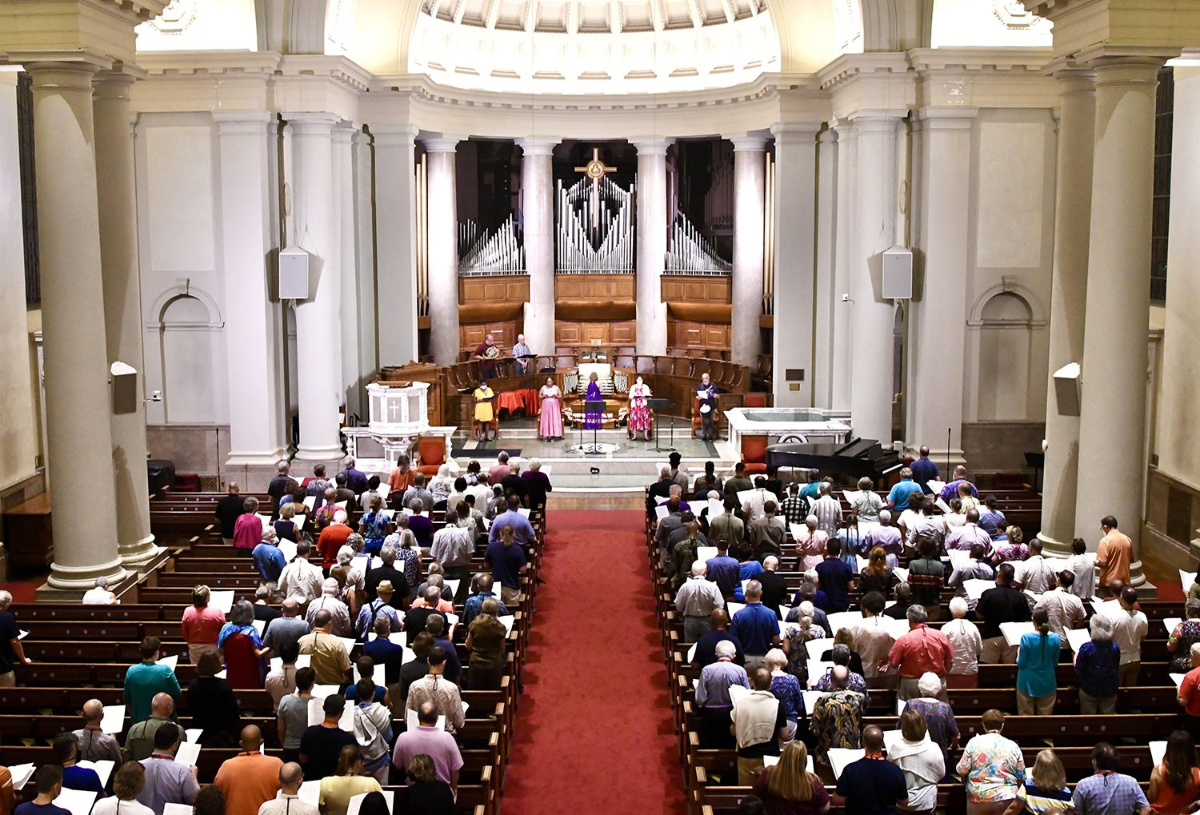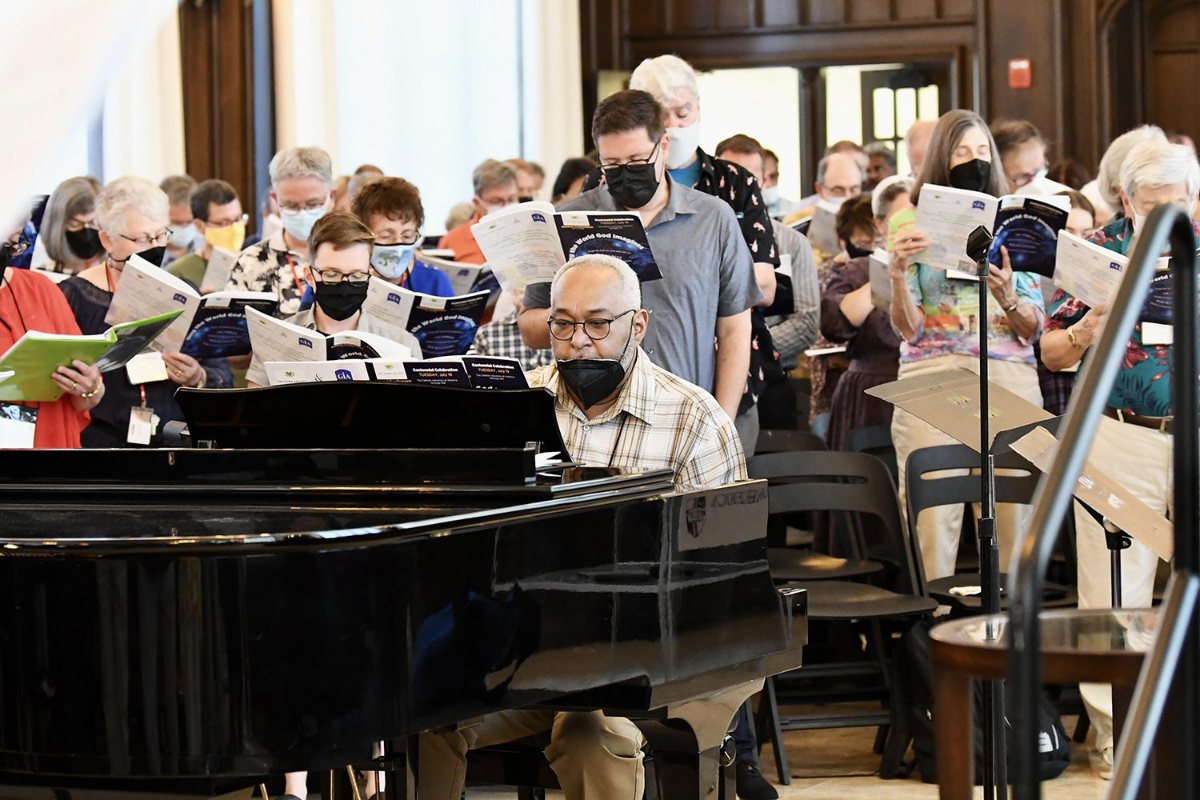
ADELLE M BANKS, of Religion News Service, reports on how members danced and sang to a global selection of hymns as they grappled with the power of song to change the world…
United States
RNS
Rahel Daulay, a Methodist who had traveled from Indonesia, was explaining the proper way to dance while singing a hymn she had brought from South-East Asia – bending knees slightly “to humble yourself” and turning toward one’s neighbors, palms together at the chest. Then turn forward, lift up the arms and hold the hands upward.
For the 300-some members of the Hymn Society in the US and Canada, who hadn’t met in person for three years, it was a liberation.
“Let us come and worship our creator,” they sang on Tuesday, the second day of their annual conference, as they swayed and danced at Catholic University’s Edward J Pryzbyla University Center. The organisation comprises representatives from more than 50 denominations who speak as many as six languages. Some had travelled almost 13,000 kilometres to attend.

Hymn Society members attend the Opening Hymn Festival of their annual conference on Sunday, 17th July, in Washington, DC. PICTURE: Courtesy of The Hymn Society/Glen Richardson
Since COVID-19 hit, many of the academics and music practitioners in attendance have not been able to sing out even in their home churches, as congregational singing has been stifled in many houses of worship for fear of spreading the virus.
Though masking was enforced, the pandemic had lifted just enough this year for organisers to go ahead with the 2022 in-person meeting, celebrating the society’s 100th year of existence.
“For the past three years, it’s been so nice to see all of your faces on screen and be together in that way, but there is nothing like seeing your faces out here and being together to sing.”
– J Michael McMahon, executive director of the Hymn Society in a greeting on Monday.
“For the past three years, it’s been so nice to see all of your faces on screen and be together in that way, but there is nothing like seeing your faces out here and being together to sing,” said Executive Director J Michael McMahon in greeting on Monday.
With the theme “Sing the World God Imagines”, the gathering demonstrated the powerful influence hymns have, not only on faith communities but also on politics and society at large across the globe, as lecture sessions addressed topics such as the ongoing effects of colonialism on the texts and tunes they choose to sing.
Consciousness of hymns’ power has driven a growing diversity in the Christian hymnody, and members and guests meeting this week insisted that the trend continue into the coming century.
“I have had the pleasure of watching this community grow to embrace and to celebrate the way the Gospel can be preached and sung and prayed in many tongues and rhythms, calling forth an array of gifts much like the first-century church,” said conference preacher Cynthia A Wilson, a United Methodist and leader of a new Black church music institute at Garrett-Evangelical Theological Seminary.
“But as we move into this century, friends, I promise we will not get through it without the boldness of protest, the power of prayer and the potency of God’s song.”

Attendees stand during a performance at the Centennial Celebration Hymn Festival. PICTURE: Courtesy of The Hymn Society/Glen Richardson
Monday’s opening worship service featured Wilson’s sermon and songs like Let it Rise, God Is Here and Order my Steps. For much of the rest of the meeting, participants, including several dozen online, took turns leading and learning unfamiliar songs from many lands as well as familiar hymns with new beats and new words.
On Wednesday, Mikako Ehara, head of church music for the Japan Baptist Convention, taught God’s World, the song featuring a Japanese folk melody based on a nursery rhyme she compared to The 12 Days of Christmas – “where a line is added with each new verse” about creation as told in the Book of Genesis.
“Let’s rejoice all together,” the song began. “Wonderful, wonderful God’s creation.”
In a prerecorded video from Australia, Tanya Riches talked about the musical evolution of Hillsong, whose music ministry has provided a thick songbook for evangelical Christian churches around the globe.
Riches, a senior lecturer at Hillsong’s college in Sydney, noted that Hillsong was once known best for Darlene Zschech’s 1993 Shout to the Lord. By 2016, however, Hillsong’s co-founder, Brian Houston, who resigned earlier this year, told conference-goers in the US that the song’s time had passed. “This song’s moment is no longer relevant to the congregation’s work in the Spirit,” Riches explained.
Rev Mikie Roberts, program executive for spiritual life and for faith and order for the World Council of Churches, described in a later plenary how his home country of Antigua and Barbuda had gained independence in 1981 in part through the use of patriotic hymns that reached people through their churches. To reach the most people, the tunes excluded the familiar syncopation of local Calypso music.
“The patriotic and the national songs had to be simple, yet direct, so that they could be promoted in schools, played on the air and sung every day including Sunday,” said Roberts, a Moravian pastor.
An international panel of speakers grappled with the origins of the hymnody in parts of the world where songs brought by Western missionaries are still revered more than other church music, including the songs of local cultures.
“We’re still in the process of decolonising what we are singing,” said Gerardo Oberman, a leader of Reformed Churches in Argentina and one of the panelists, speaking through a translator. “We are still trying to find our own voice or trying to find our own rhythms. Because there’s a little bit of a disconnect between what we sing in our homes, what we sing on the streets, and what we sing in our churches.”
We rely on our readers to fund Sight's work - become a financial supporter today!
For more information, head to our Subscriber's page.
C Michael Hawn, an Iowa native who has long advocated for including global music in American congregations’ worship services, said that, despite concerns about Western music’s dominance, some people across the globe made traditionally Western hymns genuinely their own.
“I have developed a little bit more awareness and sympathy for What a Friend We Have in Jesus being sung in Yoruba – or not just in the language, but in a style that reflects they’ve Africanized it,” said Hawn, professor emeritus of church music at Southern Methodist University’s Perkins School of Theology.
“And so it’s not a simple transplant; it’s a reconstruction, a certain kind of hybridity.”

Songs performed in coordination with live piano music were included in the Hymn Society’s Centennial Celebration Hymn Festival on Tuesday, 19th July, in Washington, DC. PICTUREL Courtesy of The Hymn Society/Glen Richardson
Within three years of the Hymn Society’s first meeting in 1922, the Baptist Standard Hymnal and The Book of American Negro Spirituals were published. But by the 1980s and 1990s, Hawn said, there was a greater consciousness of being inclusive, and hymnals began to include more global music. People developed more intentionality about “what sounds take place in a sacred space.”
Accordingly, the conference’s closing festival on Thursday, at National City Christian Church, mixed the church’s organ with the djembe, a West African drum, as well as voices and brass instruments and music by a range of composers.
“And now, as we prepare to go forth, may the spirit of God blow among us to bring forth new songs,” said McMahon as he closed the meeting, “songs of faith, songs of healing, songs of transformation, songs of peace, songs of a world remade.”






